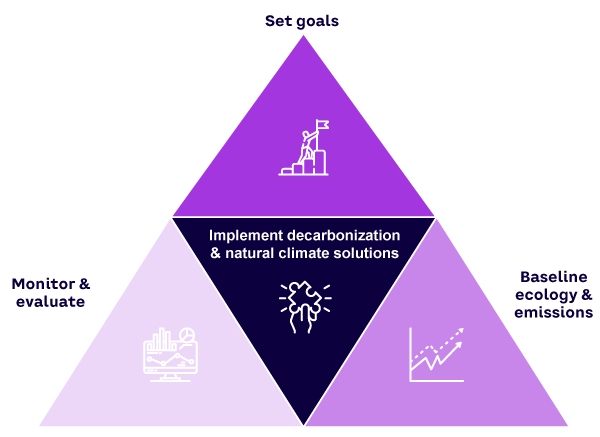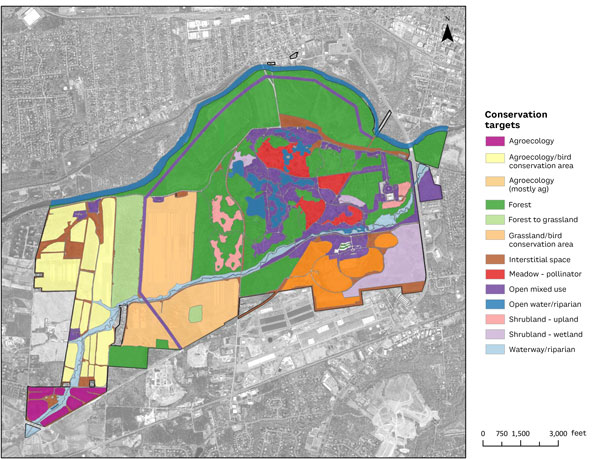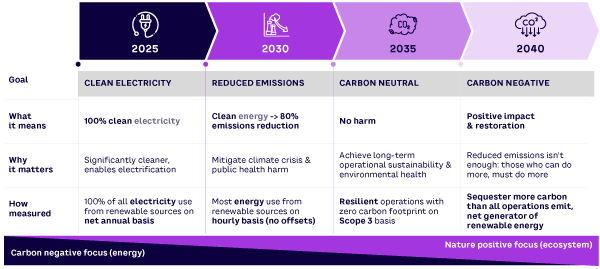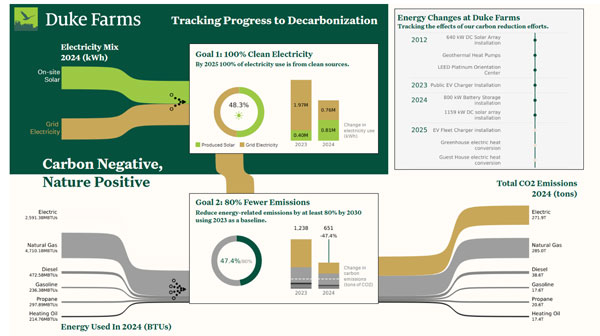AMPLIFY VOL. 38, NO. 2

How can every campus and peri-urban community drive its greenhouse gas (GHG) emissions sharply downward while managing open space to maximize biodiversity and carbon sequestration?
Duke Farms, a center of the Doris Duke Foundation in peri-urban New Jersey, USA, has developed a holistic operating framework to answer this urgent question. This framework is directly relevant and adaptable for landowners and managers worldwide, including corporate and university campuses and planned communities.
As atmospheric CO2 concentrations surpass 419 parts per million1 and national governments falter in their Paris climate commitments,2 putting Earth on track for more than 1.5°C of warming, Earth is entering its sixth mass extinction of species in 4 billion years — this time attributable entirely to human activity.3,4
Local action at scale is required to mitigate the threats of extinction and increased warming. By virtue of their mixed land-use regimes (including interwoven developed areas, agriculture, preserves and open space, and other infrastructure), campuses and peri-urban communities in the transition zones between dense urban cores and rural areas are well-positioned to support a global transition to a nature positive and carbon negative future.5 Their strategic location near major transportation corridors, ability to engage diverse populations, and opportunity for innovation and demonstration amplify their potential for scalable impact. However, lack of knowledge, incentives, resources, and/or ability to balance trade-offs can be significant barriers to progress.6,7
Ready or not, leaders across sectors (corporate, nongovernmental organizations, education, healthcare, planning and design, and government) are being pressured to act via:
-
Shareholder, employee, citizen, student, and customer demands
-
Regulations and transparency requirements
-
Resilience and recovery needs as climate and weather become unstable
-
Threats to supply chains and operational continuity
-
A sense of mission or moral obligation (in some cases)
The Duke Farms operating framework (see Figure 1) is built from four mutually reinforcing components:
-
Setting goals
-
Baselining ecology and emissions
-
Implementing solutions:
-
Prioritizing decarbonization solutions
-
Seeking natural climate solutions
-
Identifying and managing trade-offs
-
-
Monitoring and evaluating
We depict this framework as a pyramid built from interlocking components. Although the framework could be followed in a clockwise manner, our experience shows us that, ideally, each component influences the other in real time for a true adaptive management approach.

Duke Farms
Duke Farms, located in Somerset County, New Jersey, USA, is a 2,700-acre campus that comprises more than 100 buildings, grasslands, working agricultural lands, natural and constructed wetlands, forests, a public park–like landscape, and four miles of frontage on the Raritan River. The surrounding landscape is a matrix of urban and suburban communities, industrial sites, agricultural landscapes, protected areas, wetlands, and riparian corridors. In these ways, the Duke Farms campus is similar to many other campuses (corporate, education, healthcare, etc.) and similarly situated communities across the country and worldwide.
Once the estate of industrialist J.B. Duke, Duke Farms passed to his daughter, Doris Duke, a lifelong philanthropist who dedicated her legacy to charitable causes and established the Doris Duke Foundation in 1996. Today, it serves as a hub for conservation and sustainability under the foundation’s stewardship, connecting more than 150,000 visitors annually with nature through demonstrations, diverse programming, and events grounded in science-informed restoration and stewardship.
Beginning in the mid-1990s, Duke Farms began to catalog and improve the property’s biodiversity and ecology through a variety of research projects, restoration efforts, and a comprehensive land stewardship plan implemented in 2014. Duke Farms also invested in efforts like geothermal energy, onsite solar, and LEED Platinum status for several buildings. Five years ago, it started to quantify its annual and 100-year carbon footprints and potential mitigation scenarios.
Initially, staff hypothesized that natural climate solutions could fully offset remaining operational emissions, a common assumption. The real picture is more complex and is applicable to many campuses and communities. Research at Duke Farms shows that achieving net zero or carbon negative outcomes requires implementing natural climate solutions and achieving substantial reductions in operational emissions.8
Data from Duke Farms reinforces global research showing that natural climate solutions hold immense potential for carbon removal, biodiversity restoration, and delivering co-benefits to surrounding communities. Tactics like reforesting floodplains can achieve multiple outcomes simultaneously. Other proposals, like planting trees in grasslands critical to endangered species, highlight the complexity of balancing biodiversity goals with climate targets. These nuances call for clear goal setting, innovative solutions, and careful monitoring to help institutions and communities maximize ecological and climate outcomes.
So we pose a question to every leader, landowner, and land manager: What part can you play in mitigating climate change and extinction risk through your management choices?
Set Goals
Every campus and community must set clear goals to balance land-use allocations, infrastructure investments, transportation and access, stakeholder interests, and other concerns in accordance with its overarching objectives and needs.
For example, in 2023, Duke Farms refined its high-level strategic goals:
-
Restore nature and ecosystem services in peri-urban landscapes.
-
Demonstrate nature positive and equitable climate-transition strategies.
-
Engage leaders with the wonder of nature and the power to spark change.
These objectives guide Duke Farms’s decisions about land management, resource allocation, and capital investments.
Of course, leaders must also keep high-level and operational goals current in response to emerging needs, knowledge, and opportunities. For example, although Duke Farms has more than three decades of expertise in ecology and biodiversity, its efforts to quantify and mitigate GHG emissions are more recent and have been spurred by scientific data on climate impacts to biodiversity locally and globally, climate impacts to Duke Farms’s ecosystems and infrastructure, and the broader goals of the Doris Duke Foundation.
Baseline Ecology & Emissions
Designing solutions for biodiversity conservation and carbon reductions (both avoidance and removal) requires an understanding of site ecology and baseline GHGs. Many entities have spent years trying to quantify their carbon footprint but are just now beginning to wrestle with biodiversity. For example, a 2024 survey of corporate sustainability professionals found that “only one-quarter treat protecting nature and biodiversity as a high priority, compared to two-thirds that prioritize reducing greenhouse gas emissions” and that only one-tenth of the surveyed companies based in North America are taking “significant actions” for biodiversity.9
Ecology
Every human place on earth, from a community college campus to a large city, is deeply influenced by landscape features like rivers and mountains, climate variables like rainfall and temperature, and the interactions between life forms, from plants to animals to microorganisms. In addition, every landscape is shaped by its history, and in much of North America, that history includes millennia of human influence.
At the site level, building an understanding of how these factors interact (and have interacted over time) is foundational to identifying local biodiversity conservation opportunities and effective natural climate solutions. Failure to do so can deepen biodiversity losses or doom well-intended natural climate solutions projects, or both, as shown in recent research that points to:
... major administrative and governance failings in Australia’s carbon credit scheme and a significant missed opportunity to restore biodiversity-rich woodlands and forests in previously cleared lands via legitimate carbon-offset projects.10
Ecology at Duke Farms is shaped by its location in the Northern Piedmont EPA Level III Ecoregion, its Raritan River frontage, and centuries of agriculture and other human uses of the land that created a mosaic of variously aged forest, grasslands, agricultural fields, designed landscapes, buildings, roads, and wetlands (see Figure 2).

Ecological research to help Duke Farms manage for biodiversity has included vegetation studies, wildlife surveys, and hydrology assessments. In 2019, Duke Farms partnered with Rutgers University to study the carbon-sequestration potential of its habitats and land management practices to help inform natural climate solutions.
Duke Farms has relied on many partnerships and resources to build its base of ecological knowledge. Those looking to build their own scientific foundation for biodiversity and natural climate solutions should consider the following resources and entities as a starting point:
-
EPA Level III and IV Ecoregions11
-
Watershed maps
-
Nearby college and university departments and extensions
-
Local environmental consulting firms
-
State natural heritage programs and/or master naturalist programs
-
Local nonprofits like native plant societies and Audubon chapters
Emissions
In 2019, researchers from Rutgers University began to create a 100-year Duke Farms carbon footprint using operational data from 2016. Researchers estimated a baseline footprint of 1,879 metric tons of CO2 equivalent over a 100-year period, excluding natural carbon capture. The researchers also modeled various emissions reduction and natural climate-solution scenarios, ultimately concluding that there is no viable pathway to achieving net zero or carbon negative outcomes without combining aggressive emissions reductions and targeted, data-informed restoration and land management strategies to optimize carbon sequestration.12
In response, Duke Farms engaged energy consultant Gabel Associates to develop a comprehensive operational carbon footprint and specific intervention points. The analysis used utility data from both grid-supplied and onsite solar-generated electricity, natural gas, and fuel used for vehicles and equipment. In addition, a detailed energy audit evaluated efficiency and energy-conservation measures.
Many energy consultants use cost savings to the client as their primary metric to measure. Instead, Duke Farms and Gabel Associates worked together to quantify carbon emissions as the primary metric of the analyses. This approach better supports the goal of meaningful emissions-reduction solutions.
This experience shows that no entity should rely on assumptions or on modest good-faith efforts, like tree planting, to get meaningful, measurable emissions reductions. Rapid and dramatic operational decarbonization is needed to meet the challenges facing our communities and our world.
Implement Decarbonization Solutions
Building effective strategies to cut emissions and decarbonize emissions can be complex, even with supportive leadership and financial resources. The work at Duke Farm illustrates the importance of phasing the big challenges, cultivating internal champions, and engaging stakeholders along the path to decarbonization.
Phase the Big Challenges
The Rutgers University analysis found that 75% of Duke Farms’s emissions came from building operations, despite a solar array built in 2012 that provided about 50% of the campus’s electricity. Duke Farms has more than 100 buildings on campus, many more than 100 years old, creating a challenge similar to those faced by many communities and campuses with aging infrastructure.
Urgent as the decarbonization challenge may be, the work cannot be done overnight. Gabel Associates and Duke Farms developed a phased approach to drive campus emissions down as close to zero as possible (see Figure 3).

In fall 2024, Duke Farms constructed a 1,159-kW solar array and 1,600 kWh battery storage system, moving from 50% to 100% of current electricity needs and reducing emissions by 13%. The older system was paused to enable the new installation, but it remains a strategic asset that can be reactivated as Duke Farms electrifies more systems, ensuring flexibility and scalability along the decarbonization journey.
Building a data-backed roadmap to decarbonization with clear phases and milestones provides both an operational plan and an accountability framework for staff, management, and overseers. Many decarbonization efforts set only an end point 10, 20, or 30 years out, with no intermediate milestones, a sure recipe for failure.
Cultivate Internal Champions
As Duke Farms began to explore electrifying its vehicle fleet, analysis showed that the fleet’s biggest carbon emitter was a security truck. To management, that seemed an obvious place to start, but staff were quick to raise reliability and safety concerns about replacing the truck with an electric vehicle (EV). The effort came to a halt in the face of operational and cultural barriers.
However, Duke Farms’s electrician emerged as a staff champion for fleet electrification. He needed a new vehicle and requested an electric van, of which he became a vocal proponent. At the same time, Duke Farms’s motor pool coordinator learned all he could about EVs with a goal of figuring out how to make EV adoption feasible and effective on site.
A plan by management to decarbonize the fleet was not enough — it took identifying and cultivating champions who could demonstrate the effectiveness of EVs to their peers, dispel myths, problem solve, and accelerate broader adoption.
Engage Stakeholders
Some of the more difficult aspects of decarbonization require strong stakeholder engagement. For example, transportation emissions are a major source of Scope 3 emissions for Duke Farms and the largest contributor to carbon emissions in New Jersey. Although Duke Farms’s carbon negative roadmap does not directly include Scope 3 emissions, it recognizes the opportunity to educate and engage a broader community on transportation.
In alignment with New Jersey’s commitment to electrifying transportation, Duke Farms installed a car fast-charging station in 2023, leveraging state and utility incentives.13 Powered by on-site solar, the station serves employees, visitors, and the public, addressing a critical gap as the only fast-charging facility in the immediate area. Through initiatives like this, Duke Farms advances state goals and fosters community engagement and advocacy, building momentum for broader societal shifts while contributing to the collective effort to address Scope 3 emissions.
Implement Natural Climate Solutions
There is significant investment and interest in carbon-capture technology, but natural climate solutions remain the most readily available and proven methods for removing atmospheric carbon at scale and storing it in soils and plant biomass. Well-designed approaches also promote biodiversity and healthy ecosystem functions that benefit people. Unfortunately, poorly governed carbon-credit schemes and misguided tree-planting efforts have tarnished natural climate solutions.
Duke Farms found that relying only on natural climate solutions is, indeed, foolhardy. In the year 2025, every leader must pursue aggressive decarbonization strategies across Scopes 1, 2, and 3. However, dismissing natural climate solutions is also foolish, akin to fighting climate change with one hand tied behind our backs, not to mention ignoring the co-benefits for people and nature that come with well-designed natural climate solutions.
The Doris Duke Foundation has long supported research into natural climate solutions and provided research funding that led to a seminal paper that found:
[Natural climate solutions] can provide over one-third of the cost-effective climate mitigation needed between now and 2030 to stabilize warming to below 2°C. Alongside aggressive fossil fuel emissions reductions, [natural climate solutions] offer a powerful set of options for nations to deliver on the Paris Climate Agreement while improving soil productivity, cleaning our air and water, and maintaining biodiversity.14
Governments like the State of New Jersey are pursuing national climate solutions, as are private sector initiatives like 1t.org.15,16 Work at Duke Farms shows that to be effective, natural climate solutions must be backed by data, promote biodiversity win-wins, and focus on long-term gains in sequestered carbon.
Pursue Data-Backed Solutions
Research by Rutgers University scientists at Duke Farms shows that the biggest opportunity for onsite carbon sequestration lies in the deep, wet soils of the Raritan River floodplain. Intensive soil and forest carbon-quantification and gas-exchange analyses show that reforesting these lands for 100 years or more will result in significant carbon sequestration.
After working on two test plots, Duke Farms has now partnered in a 112-acre reforestation project in this vital floodplain. The project fulfills a downstream responsible party’s obligation to restore floodplain, riverbank, and wetland resources, and it will maximize carbon sequestration by growing new forest in abandoned agricultural fields previously drained and cleared for farming. The new forest will absorb river flooding and create new habitats for wildlife along this heavily urbanized river.
Work at Duke Farms also shows that “proforestation” solutions (helping existing forests grow to full potential) are important to keep existing forests healthy and sequestering carbon for the long term.17 In peri-urban environments with many stressors, forest health can decline over time, leading to a loss in carbon-sequestration capacity. Research at Duke Farms shows that the following land management tactics are important to maximize forest carbon storage:18
-
Managing white-tailed deer population density to sustainable levels
-
Leaving deadwood in place wherever safe and practical (and reusing onsite [e.g., for mulch, when needed])
-
Enhancing forest-block connectivity to reduce carbon losses due to windthrow events, invasive species, and other threats
Promote Biodiversity Win-Wins
Research at Duke Farms shows that the Norway maple (Acer platanoides) has high carbon-sequestration potential. That tree, however, is native to Eurasia. In North America, it is an invasive species that chokes out native species and does not support the insect populations on which native birds and other wildlife depend, weakening the food web.
By planting with native North American tree species that have high carbon-sequestration potential, like red maple (Acer rubrum), Duke Farms can promote biodiversity and local ecosystem health through floodplain forest reforestation work and other initiatives.
Focus on Long-Term Gains
Fires, droughts, storms, floods, and changes in land management practices can kill vegetation, disturb soils, and release accumulated carbon back into the atmosphere. As much as possible, building long-term maintenance funding into projects, creating durable governance structures, and mitigating threats like deer browse and drought in the first few years of a plant’s life must be part of the work, along with a long-term commitment to monitoring and assessing carbon- sequestration gains.
Identify & Manage Trade-Offs
Optimizing for both carbon mitigation and biodiversity requires identifying and managing trade-offs. For example, when researchers from Rutgers University assessed the carbon-sequestration potential of land management practices at Duke Farms, they found that reforesting Duke Farms’s grassland habitats could sequester more carbon over time than maintaining the historic grasslands. Furthermore, because Duke Farms maintains grasslands through rotational grazing of a small cattle herd to improve soil health and support biodiversity, converting the grasslands to forest could significantly reduce or eliminate ongoing GHG emissions from the cattle operation (about 8% of Duke Farms’s total carbon footprint).
However, as discussed, one of Duke Farms’s top-level goals is to protect and restore biodiversity, particularly threatened and endangered species. In North America, birds that depend on grassland habitats have declined more dramatically since 1970 than any other group of terrestrial birds, due to large-scale conversion of grasslands into other land-use regimes.19 Duke Farms’s agricultural grasslands have become a vital habitat for several imperiled grassland bird species like bobolink, Savannah sparrow, and grasshopper sparrow and have natural heritage designation by the state.20 Converting these grasslands to forest would send these bird populations further into decline, so this course of action is not a viable option for Duke Farms.
Having made the goal-driven decision to maintain some grassland habitat for the sake of biodiversity, the Duke Farms team can focus on how to minimize GHG emissions from the rotational grazing operation (e.g., by reducing lime and fertilizer applications and by improving cattle diets and genetics) and how to maximize the carbon-sequestration potential of the grassland habitats by promoting native plant species diversity, leaving vegetation in place through the winter, and other tactics.
Monitor & Evaluate
Leaders must put data gathering and monitoring protocols in place for emissions-reduction, carbon-sequestration, and biodiversity goals. Setting goals and undertaking activities is not enough — progress must be tracked and reviewed regularly by leaders who are accountable and empowered to make operational changes based on the data.
Duke Farms monitors biodiversity through the efforts of staff, volunteers, consultants, researchers, and students, tracking a wide range of plant and animal species. This collaborative approach informs its science-based restoration and biodiversity conservation efforts as part of an adaptive management framework outlined in the Land Stewardship Plan. In 2024, Duke Farms developed a dashboard system to track monthly and annual operating emissions over time (see Figure 4).
The monitoring responsibility extends to external environments and trends. For example, Duke Farms has not yet replaced its diesel tractors with EVs because the technology is not yet commercially available. The farm and fleet staff are charged with tracking technological progress and products on the market to understand when the moment is right to take this critical step.

Collaborating for Success
Duke Farms is a place where innovation meets collaboration — a living laboratory designed to inspire and equip others to act. As we tackle the challenges of decarbonization and sustainability, we recognize that success lies in our ability to share what we learn and work across sectors to develop scalable solutions. By serving as a model and a convener, Duke Farms is committed to breaking down barriers, fostering partnerships, and empowering communities to join us in shaping a cleaner, more resilient future.
References
1 ”As Pollution Increases, World Falls Further Behind Climate Targets.” US National Oceanic and Atmospheric Administration (NOAA), 13 November 2024.
2 Nuccitelli, Dana. “Here’s How Governments Could Fix Their Paris Climate Commitment Failures.” Yale Climate Connections, 15 November 2024.
3 De Vos, Jurriaan M., et al. “Estimating the Normal Background Rate of Species Extinction.” Conservation Biology, Vol. 29, No. 2, August 2014.
4 Díaz, S., et al. (eds.). “Summary for Policymakers of the Global Assessment Report on Biodiversity and Ecosystem Services.” Intergovernmental Science-Policy Platform on Biodiversity and Ecosystem Service (IPBES), 25 November 2019.
5 Here, we define “campus” as a parcel of land containing both buildings and open space used for one or more human purposes.
6 Barral, Stéphanie, and Fanny Guillet. “Preserving Peri-Urban Land Through Biodiversity Offsets: Between Market Transactions and Planning Regulations.” Land Use Policy, Vol. 127, April 2023.
7 Malano, Hector, et al. “Challenges and Opportunities for Peri-Urban Futures.” In The Security of Water, Food, Energy and Liveability of Cities, edited by Basant Maheshwari et al. Springer, 2014.
8 In this article, we use “carbon negative” to refer to operations that sequester more carbon than they emit through a combination of emissions reductions and natural climate solutions to pull carbon out of the air.
9 Lieb, Theresa, Alex Novarro, and Saul Hansell. “The State of Biodiversity and Business 2024.” Trellis, 2024.
10 Macintosh, Andrew, et al. “Non-Compliance and Under-Performance in Australian Human-Induced Regeneration Projects.” The Rangeland Journal, Vol. 46, October 2024.
11 “Level III and IV Ecoregions by State.” US Environmental Protection Agency (EPA), 26 December 2024.
12 Gimenez, Daniel, et al. “Carbon Mitigation Research and Monitoring Program at Duke Farms.” Rutgers, The State University of New Jersey, 31 July 2024.
13 “New Jersey’s National Electric Vehicle Infrastructure (NEVI) Deployment Plan.” New Jersey Department of Transportation/New Jersey Department of Environmental Protection/New Jersey Board of Public Utilities/New Jersey Economic Development Authority/Gannett Fleming, 1 August 2022.
14 Griscom, Bronson W., et al. “Natural Climate Solutions.” Proceedings of the National Academy of Sciences of the United States of America (PNAS), Vol. 114, No. 44, October 2017.
15 1t.org website, accessed 2025.
16 In fall 2024, the State of New Jersey released its strategy to advance carbon sequestration on its natural and working lands; see: “Natural and Working Lands Strategy.” New Jersey Department of Environmental Protection, accessed 2025.
17 Moomaw, William R., Susan A. Masino, and Edward K. Faison. “Intact Forests in the United States: Proforestation Mitigates Climate Change and Serves the Greatest Good.” Frontiers in Forests and Global Change, Vol. 2, June 2019.
18 Gimenez et al. (see 12).
19 “State of the Birds 2022.” US Committee of the North American Bird Conservation Initiative (NABCI), accessed 2025.
20 These three grassland bird species contributed to Duke Farms’s designation as a formal Important Bird Area by the National Audubon Society; see: “Important Bird Areas.” Audubon, accessed 2025.





